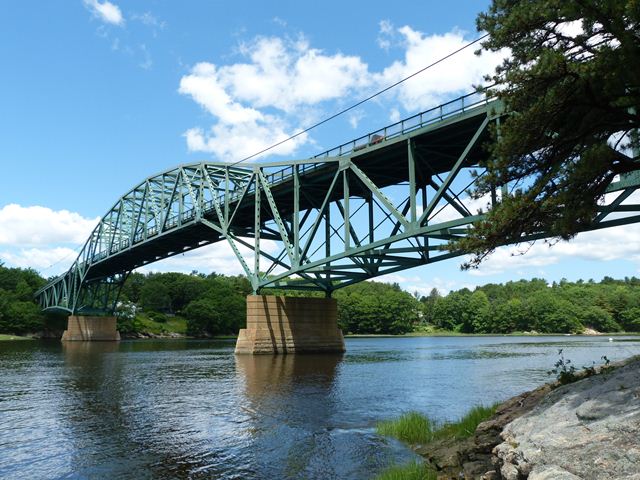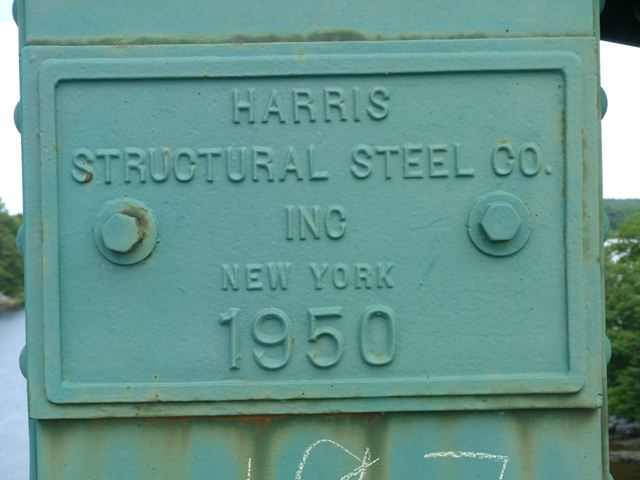We Recommend:
Bach Steel - Experts at historic truss bridge restoration.
BridgeHunter.com Phase 1 is released to the public! - Visit Now
Arrowsic Bridge
Max L. Wilder Memorial Bridge

Primary Photographer(s): Nathan Holth
Bridge Documented: June 15, 2012
Rural: Sagadahoc County, Maine: United States
1950 By Builder/Contractor: Harris Structural Steel Company of New York, New York and Engineer/Design: Max L. Wilder, Maine State Highway Commission
1985
300.0 Feet (91.4 Meters)
838.0 Feet (255.4 Meters)
24 Feet (7.32 Meters)
3 Main Span(s) and 4 Approach Span(s)
2026

View Information About HSR Ratings
Bridge Documentation
View Archived National Bridge Inventory Report - Has Additional Details and Evaluation
The Arrowsic Bridge is an example of an uncommon, but highly attractive design of truss bridge often called a "arched truss." The design includes a center span that is a through truss with a polygonal top chord, and the truss seamlessly transitions into a deck truss span at each side of the bridge. The design is related to the "suspended-deck truss" however in the arched truss design, the through truss does not rise as far above the roadway and so does not require the deck to be suspended by hangers from the truss. Like the suspended-deck truss, a completed arched truss can either exhibit a cantilever or continuous configuration. The Arrowsic Bridge is a cantilever truss, as evidenced by the pins at particular connection points, providing a hinge, and defining distinct cantilever arms holding a suspended span. Constructed in 1950, this bridge is not a particularly early example of the type (early examples date to the 1930s or earlier) however it is significant in the state context since it is the only known example of its type in Maine, and was additionally designed by noteworthy Max L. Wilder of the Maine State Highway Commission. This bridge is considered to be one of his most important engineering achievements, and the bridge was later officially renamed to the Max L. Wilder Memorial Bridge.
Information and Findings From Maine's Historic Bridge InventoryDiscussion of Bridge "The 1950 cantilever thru truss bridge is a handsome, well-proportioned, and complete example of a bridge type and design that represents the conservative use of well-established bridge technologies by state bridge engineer Max L. Wilder. Although the type and design had been used for railroad and highway bridges since the late 19th century, the cantilever-suspended section design was not used for truss bridges in Maine until after World War II. This is a particularly fine example, and it is possibly the finest or one of the two finest bridges designed under Wilder's leadership. It was constructed without falsework. It was named in his honor in 1963. Max Wilder was state bridge engineer from 1929 until 1962. The bridge is judged to have high preservation priority because it is a rare example of its design. It is the only cantilevered thru truss highway bridge in the state. It is also associated with a state context that is of greater than average significance." Bridge Considered Historic By Survey: Yes |
![]()
Photo Galleries and Videos: Arrowsic Bridge
Structure Overview
Original / Full Size PhotosA collection of overview photos that show the bridge as a whole and general areas of the bridge. This gallery offers photos in the highest available resolution and file size in a touch-friendly popup viewer.
Alternatively, Browse Without Using Viewer
![]()
Structure Details
Original / Full Size PhotosA collection of detail photos that document the parts, construction, and condition of the bridge. This gallery offers photos in the highest available resolution and file size in a touch-friendly popup viewer.
Alternatively, Browse Without Using Viewer
![]()
Structure Overview
Mobile Optimized PhotosA collection of overview photos that show the bridge as a whole and general areas of the bridge. This gallery features data-friendly, fast-loading photos in a touch-friendly popup viewer.
Alternatively, Browse Without Using Viewer
![]()
Structure Details
Mobile Optimized PhotosA collection of detail photos that document the parts, construction, and condition of the bridge. This gallery features data-friendly, fast-loading photos in a touch-friendly popup viewer.
Alternatively, Browse Without Using Viewer
![]()
Northbound Crossing
Full Motion VideoStreaming video of the bridge. Also includes a higher quality downloadable video for greater clarity or offline viewing.
![]()
Maps and Links: Arrowsic Bridge
Coordinates (Latitude, Longitude):
Search For Additional Bridge Listings:
Bridgehunter.com: View listed bridges within 0.5 miles (0.8 kilometers) of this bridge.
Bridgehunter.com: View listed bridges within 10 miles (16 kilometers) of this bridge.
Additional Maps:
Google Streetview (If Available)
GeoHack (Additional Links and Coordinates)
Apple Maps (Via DuckDuckGo Search)
Apple Maps (Apple devices only)
Android: Open Location In Your Map or GPS App
Flickr Gallery (Find Nearby Photos)
Wikimedia Commons (Find Nearby Photos)
Directions Via Sygic For Android
Directions Via Sygic For iOS and Android Dolphin Browser
USGS National Map (United States Only)
Historical USGS Topo Maps (United States Only)
Historic Aerials (United States Only)
CalTopo Maps (United States Only)





